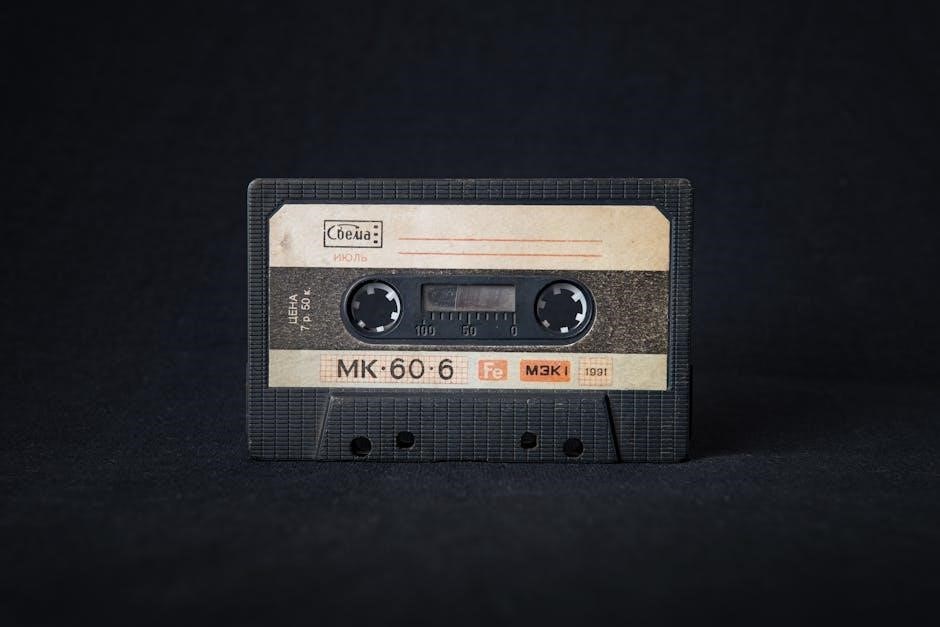Plantar fasciitis is inflammation of the plantar fascia, causing heel pain and discomfort. It often results from overuse, poor foot mechanics, or repetitive stress. KT Tape can help alleviate symptoms by providing arch support and reducing strain on the plantar fascia, offering a non-invasive solution for pain relief.
1.1 What is Plantar Fasciitis?
Plantar fasciitis is a common condition characterized by inflammation of the plantar fascia, a thick band of connective tissue that runs along the bottom of the foot, from the heel to the toes. This inflammation leads to pain and stiffness, particularly in the heel and arch of the foot. It is often caused by overuse, poor foot mechanics, or repetitive stress, and can be exacerbated by factors such as obesity, tight calf muscles, or wearing improper footwear. Symptoms typically include sharp pain in the heel, especially after periods of rest, and may improve with movement but worsen with prolonged activity. If left untreated, it can significantly impact daily activities and quality of life.
1.2 Causes and Symptoms
Plantar fasciitis is primarily caused by overuse, repetitive stress, or poor foot mechanics. Factors such as obesity, tight calf muscles, or wearing improper footwear can exacerbate the condition. Symptoms include sharp heel pain, often worse in the morning or after periods of inactivity. Pain may subside with movement but can worsen with prolonged activity. Inflammation of the plantar fascia leads to stiffness and discomfort, particularly in the arch and heel. If untreated, it can significantly impact daily activities and overall mobility. Early recognition of symptoms is crucial for effective management and preventing further complications.

What is KT Tape?
KT Tape is a kinesiology tape designed to provide dynamic support and promote blood flow. It’s commonly used for injuries like plantar fasciitis to reduce pain and inflammation.
2.1 Overview of KT Tape
KT Tape is a specialized kinesiology tape designed for athletic and therapeutic use. It is made from breathable, water-resistant materials and features a gentle adhesive that conforms to the skin. The tape is available in various colors and widths, ensuring versatility for different applications. Unlike traditional athletic tape, KT Tape allows for a full range of motion while providing support and stability. It is commonly used to treat injuries such as plantar fasciitis, shin splints, and tendonitis. The unique design of KT Tape helps to lift the skin, promoting blood flow and reducing inflammation. This makes it an effective tool for both prevention and recovery.
2.2 Benefits of Using KT Tape for Foot Support
KT Tape provides exceptional support for the foot, particularly for individuals suffering from plantar fasciitis. It helps reduce strain on the plantar fascia by offering Stability and promoting proper foot mechanics. The tape’s breathable and water-resistant design ensures comfort during extended wear. It also enhances blood flow, which can accelerate healing and reduce inflammation. Unlike rigid athletic tapes, KT Tape allows for a full range of motion, making it ideal for active individuals. Additionally, it can be used in conjunction with other treatments, such as stretching or orthotics, to enhance recovery. Its versatility and ease of use make it a popular choice for both athletes and non-athletes seeking foot support.

How to Apply KT Tape for Plantar Fasciitis
Applying KT Tape for plantar fasciitis involves strategic placement to support the arch and heel, providing stability and comfort. Tutorials and guides are widely available online.
3.1 Step-by-Step Application Guide
To apply KT Tape for plantar fasciitis, start by cleaning and drying the foot. Place an anchor strip at the heel, then apply a support strip along the arch. Add a heel-to-ball strip for additional stability. Finish with a final support strip across the arch. Ensure the tape is smooth and wrinkle-free for optimal adhesion. This method promotes blood flow, reduces inflammation, and provides arch support. Apply before activity for best results. For detailed instructions, download a PDF guide or watch video tutorials. Proper taping can enhance comfort and alleviate pain during daily activities or exercise.
3.2 Common Taping Methods (Low Dye, Calcaneal)
Two popular taping techniques for plantar fasciitis are the Low Dye and Calcaneal methods. The Low Dye technique involves placing strips under the foot, starting at the heel and extending to the ball, providing arch support and reducing strain. The Calcaneal method focuses on the heel, with strips wrapped around the Achilles tendon to stabilize the heel bone. Both methods aim to alleviate pain and improve foot function. These techniques are often used in clinical settings and are effective for short-term pain relief. Studies suggest that Low Dye and Calcaneal taping can significantly reduce discomfort and improve mobility in patients with plantar fasciitis. For detailed instructions, refer to downloadable PDF guides or video tutorials.

Effectiveness and Benefits
KT Tape effectively alleviates plantar fasciitis pain by providing arch support and promoting blood flow. Studies show it reduces short-term pain and improves mobility, offering a non-invasive solution.
4.1 How KT Tape Helps Alleviate Pain
KT Tape alleviates plantar fasciitis pain by providing mechanical support to the arch and plantar fascia. It gently lifts the skin, improving blood flow and reducing inflammation. The tape’s elastic properties help reduce strain on the fascia, minimizing discomfort during movement. Additionally, KT Tape can inhibit pain signals to the brain through sensory stimulation, offering immediate relief. Its application creates a supportive environment for healing while allowing natural movement. Studies show that KT Tape is particularly effective in reducing short-term pain, making it a popular choice for managing plantar fasciitis symptoms.
4.2 Comparison with Traditional Athletic Tape
KT Tape differs from traditional athletic tape by offering dynamic support that allows for a full range of motion. Unlike rigid athletic tapes that restrict movement, KT Tape’s elastic properties provide gentle, consistent pressure, enhancing comfort and flexibility. It also promotes blood flow by lifting the skin, which traditional tapes do not. While both options provide support, KT Tape is specifically designed for pain relief and injury recovery, making it more suitable for plantar fasciitis. Additionally, KT Tape can be worn for longer periods without causing skin irritation, making it a preferred choice for ongoing foot support and pain management.

Scientific Evidence and Research
Research supports KT Tape’s effectiveness in reducing plantar fasciitis pain, outperforming traditional methods and sham interventions, as confirmed by a 2023 study in the Journal of Back and Musculoskeletal Rehabilitation.
5.1 Studies on KT Tape’s Effectiveness
Research highlights KT Tape’s effectiveness in alleviating plantar fasciitis symptoms. A 2023 study in the Journal of Back and Musculoskeletal Rehabilitation found KT Tape significantly reduced pain compared to sham interventions. Another study by Zhao and Jiang demonstrated improved functional performance with KT Tape. These findings suggest KT Tape provides short-term pain relief and supports foot function, making it a valuable conservative treatment option for plantar fasciitis. The tape’s ability to promote blood flow and reduce inflammation aligns with its effectiveness in clinical settings. Such studies reinforce KT Tape as a recommended solution for managing heel pain and improving mobility in patients with plantar fasciitis.
5.2 Research on Taping Techniques
Research on taping techniques for plantar fasciitis highlights the effectiveness of methods like Low Dye and Calcaneal taping. A 2023 study found that KT Tape significantly reduced pain and improved functional performance compared to traditional taping. The FAST taping method also showed promise in diminishing heel pain effectively. These techniques provide dynamic support, reducing strain on the plantar fascia while allowing natural movement. Studies emphasize the short-term benefits of taping in alleviating symptoms and improving mobility. Such findings underscore the importance of proper taping methods in managing plantar fasciitis, offering patients a practical and non-invasive approach to pain relief and foot support.
Additional Recovery Tips
Combining KT Tape with rest, stretching, and ice therapy enhances recovery. Massage and foam rolling also reduce tension, while proper footwear supports long-term healing and prevention.
6.1 Combining KT Tape with Other Treatments
KT Tape can be effectively combined with other treatments to enhance recovery from plantar fasciitis. Rest is crucial to avoid further strain, while stretching exercises, particularly for the calves and hamstrings, improve flexibility and reduce tension. Ice therapy helps decrease inflammation, and massage or foam rolling can relax tight muscles. Additionally, wearing supportive footwear and orthotic inserts can address underlying issues like overpronation. For severe cases, anti-inflammatory medications or physical therapy may be necessary. Combining these methods with KT Tape creates a comprehensive approach, offering both immediate pain relief and long-term healing benefits. This multi-faceted strategy is often recommended for optimal results.
6.2 Importance of Rest and Stretching
Rest and stretching are vital components in managing plantar fasciitis. Allowing the foot to heal through periods of reduced activity prevents further irritation. Stretching exercises, particularly for the calves, hamstrings, and Achilles tendon, can significantly reduce tension in the plantar fascia. Gentle movements, such as toe curls and heel raises, promote flexibility and strength. Incorporating these practices into a daily routine can enhance the effectiveness of KT Tape by addressing the root causes of pain. Over time, consistent rest and stretching can lead to sustained relief and improved foot function, making them essential for long-term recovery and prevention of recurrence.
KT Tape is a valuable tool for managing plantar fasciitis, offering both support and pain relief. For comprehensive guides, downloadable PDFs and video tutorials are available online, providing detailed instructions and tips for effective application and complementary recovery strategies.
7.1 Final Thoughts on Using KT Tape
KT Tape is a practical and effective solution for managing plantar fasciitis symptoms. By providing arch support and promoting blood flow, it helps alleviate pain and discomfort. While it doesn’t cure the condition, it offers a non-invasive way to enhance recovery. Combined with rest, stretching, and proper footwear, KT Tape can significantly improve daily comfort. For best results, ensure correct application using step-by-step guides or video tutorials. Over time, consistent use can reduce strain on the plantar fascia, making it a valuable addition to your treatment plan. Always consult a healthcare professional for a comprehensive approach to managing plantar fasciitis effectively.
7.2 Downloadable PDF Guides and Tutorials
Downloadable PDF guides and tutorials provide step-by-step instructions for applying KT Tape to alleviate plantar fasciitis symptoms. These resources often include visual aids, detailed techniques, and tips for optimal taping. Many guides are available online, offering convenient access to proven methods. They cover various taping styles, such as the low dye and calcaneal techniques, ensuring users can find the most suitable approach. Additionally, these PDFs may include maintenance tips, troubleshooting, and complementary recovery strategies. By following these guides, individuals can confidently apply KT Tape at home, enhancing their treatment plan and improving comfort. These resources are invaluable for those seeking a user-friendly approach to managing plantar fasciitis effectively.
